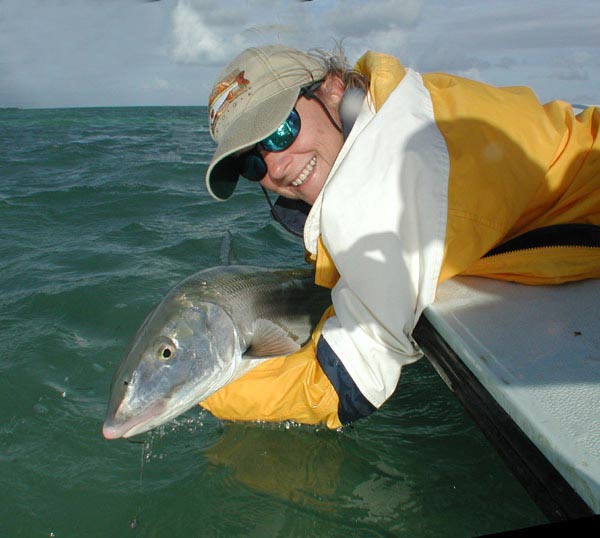Easy Cleaning
A lazy man's guide go spring cleaning
All right...I admit it. I'm really a lazy and cheap kind of guy. Given a pleasantly sunny spring day, I'd much rather be sitting in the cockpit with a cold brew than laboring away trying to get a winter's worth of dirt and grunge off the boat. There are, of course, a lot of companies that make all sorts of chemical preparations that are guaranteed to do this or that, but they all seem awfully expensive to my Scots blood. So what I'd like to share with you are the results of my lifelong quest for simple and inexpensive ways to get the boat clean with the least effort.
My trawler has a combination of laid teak and fiberglass non-skid, while the rails are both teak and stainless steel. For the non-skid fiberglass, I go against all the experts and have been happily using water and Bon-Ami dry cleanser with a stiff-bristled brush for years. It's the only thing that seems to really knock the dirt out of the non-skid and I haven't abraded away from the gelcoat finish yet.
I like my teak decking to remain light-colored, so I'm automatically faced with needing regular applications of teak cleanser. I've been using Teak Brite for years and have been satisfied with it, although there is a multitude of other solutions that I suspect work just as well. I scrub the cleanser into a thick paste and let it sit before hosing it off. The drawback to light teak, of course, is that it starts to weather immediately to that drab gray color.
I have teak rails around both the deck and flybridge and, though I tried oiling them at one time, I've resorted to varnish. The oil was incredibly messy (or I was exceedingly clumsy) and seemed to turn dark almost immediately. Teak is an oily wood, so you have to prepare the bare teak carefully, but I love the radiant glow of nicely varnished teak.
For hull and cabin sides, I use liquid detergent in warm sudsy water to scrub away dirt and dark smudges where rainwater drains off the deck. Because mildew thrives on phosphate, I use only low-phosphate detergents in case it doesn't all get rinsed off.
The following list covers a variety of materials that need cleaning, as well as Cap'n Bill's handy elixirs. A word of caution, however: test everything on a small (out of sight) area first, because there are so many fabrics available today that generalities sometimes lead to problems. In no particular order:
Brass
To remove tarnish, you can spend time using traditional brass polish, or you can wet a rag with Teak Brite and wipe the tarnish off in one pass. I prefer the latter.
Copper
Lightly scrub the metal with the cut end of a lemon dipped in salt ... the shine will be blinding!
Engines
I keep my engines clean with Gunk, a spray cleanser that goes onto a cold engine and is hosed off with fresh water. There are some cleansers for use on hot engines, which seem to work faster because the oil and grease are warm and loose, but I dislike the fumes so I take a little longer with a cold engine block.
Cushion Creases
I have white vinyl cushions for the bridge, and the tiny creases around the seam piping literally grow mildew. My solution is to mix 1/4 cup of ammonia to 4 cups of water and then scrub the crease thoroughly with a toothbrush (not my good one!) dipped in the liquid. After rinsing, I dry the crease gently with a hairdryer.
Cushion Stains:
For particularly tough stains on white vinyl cushions, including flotation cushions, I mix one teaspoon of ammonia, 1/4 cup of hydrogen peroxide, and 3/4 cup of distilled water. For some reason, the bubbling of the peroxide seems to float away stubborn blemishes.
Bunk Cushion Bottoms
Most bunk cushions have a white cotton bottom that always seems to get ugly black blemishes of mold and mildew. To clean them up, I soak them in chlorine bleach (without getting the colored top fabric wet!) and then dip the affected areas in a weak mixture of white vinegar and water to counteract the bleaching action.
Plastic Portholes
I have acrylic ports in some cabins that pick up a haze that doesn't come off with normal washing with Windex, but the same mixture of vinegar and water wipes it right away.
Scratched Plastic Portholes
There are a number of commercial products for removing minor scratches, but I prefer Skippy. That's right ... good old fashioned non-crunchy style peanut butter is a perfect rubbing compound for plastic. If you've used it all for sandwiches, you can also use a mild toothpaste for the same effect. If you have deeper scratches, the pilot shops at the local private plane airport often have inexpensive polishes for plastic aircraft windows that will do the trick.
Varnished Bulkheads
In the galley, cooking can dull the varnish on bulkheads and ceilings, but a wipe down with a soft cloth and a mild ammonia and water solution will restore the shine.
Leather
Sailboats often use leather reinforcing on sails or covers, and wet leather can pick up mildew quickly. A weak solution of water and alcohol will remove the mildew without injuring the leather, and regular washing with saddle soap or the "hide food" used to preserve sports car leather seats will keep the material supple.
Mildewed Wood
Older wooden boats often have problems with mildew forming on stringers and frames deep in the bilge, but a rag dipped in a bucket of warm water laced with a shotglass of kerosene will both remove the mildew and forestall its return.
Aluminum
If you want to put a shine back onto an aluminum fitting, try rubbing it with the shiny side of a piece of aluminum foil. You'll be amazed at how quickly the gloss returns, but don't try it on anodized aluminum because it will remove the finish.
Fenders
I tried everything on dirty white fenders, from acetone (it makes them sticky for days!) to Ajax (it dulls their finish) until someone told me about wiping them down with mineral spirits. The dirt and scuffs come off and they look like new. You can use mineral spirits on anything similar, such as the flexible cowl vents and the PVC winch handle holders on sailboats.
Masking Tape
Nothing is as frustrating as trying to peel off day-old (or week-old!) masking tape, which has welded itself to whatever you were painting. If you run lighter fluid so that it seeps under the edges of the tape and then wait a few minutes, the tape will usually slip off without any residue.
Duct Tape
Sometimes called gaffer's tape (in Hollywood), this silvery tape is indispensable for quick repairs on board, but it often leaves a nasty residue of glue behind. A rag dampened with denatured alcohol will take off all those sticky spots without marring the surface.
Iceboxes, Refrigerators and Ice Chests
To clean them as well as make them fresh-smelling again, nothing works as well as a thick paste of baking soda and water. When you restock your coldbox, leave an opened carton of baking soda (wedged so it won't tip) inside to soak up smells.
Stainless Steel
As they say ... stainless steel isn't. Machining or cutting stainless steel requires a milder steel tool, which leaves particles of rust-producing metal that soon become ugly blotches. You'll never get rid of them completely, but you can remove them with oxalic acid. I used to dissolve the crystals to form a solution, but that can be messy and this powerful bleach can really damage a deck or topsides. Now I use oxalic acid in a gel form, which sticks to vertical stanchions without dribbling and, when hosed off, removes the rust stains completely.
Sails and Covers
To get rust stains off white sails or covers, try soaking the rusty spot in a mild solution of oxalic acid for 15 to 30 minutes before rinsing very thoroughly.
Blood
On white fabrics, make a thick paste of dry laundry detergent and warm water, and let stand on the spot for 20 minutes before rinsing.
Oil and Tar:
Scrape off the thick residue with a knife blade or putty knife, and put a clean rag soaked in drying cleaning fluid under the fabric below the stain. Using another clean rag and more of the same fluid, pat the spot gently to force the tars through the material into the bottom rag. You'll always have a brown blemish, but it won't be nearly as bad as before.
Now that I've made a pitcher of lemonade (setting the rinds aside to polish the copper in the galley later) and a peanut butter sandwich (leaving enough to fix the scratches in the bridge windscreen), I'm going to sit in the cockpit and watch the other boat owners struggle through spring cleaning.











